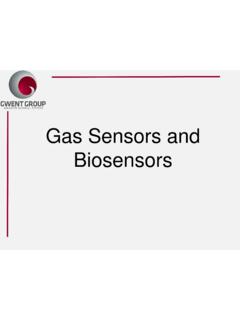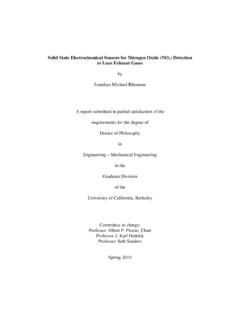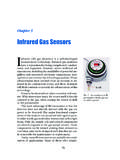Transcription of Ammonia sensors and their applications—a review - Miun
1 sensors and Actuators B 107 (2005) 666 677 Ammonia sensors and their applications a reviewBj orn Timmer , Wouter Olthuis, Albert van den BergMESA+Research Institute, University of Twente, Enschede, Box 217, 7500AE Enschede, The NetherlandsReceived 14 May 2004; received in revised form 12 November 2004; accepted 15 November 2004 Available online 16 March 2005 AbstractMany scientific papers have been written concerning gas sensors for different sensor applications using several sensing principles. Thisreview focuses on sensors and sensor systems for gaseous Ammonia . Apart from its natural origin, there are many sources of Ammonia ,like the chemical industry or intensive life-stock.
2 The survey that we present here treats different application areas for Ammonia sensorsor measurement systems and different techniques available for making selective Ammonia sensing devices. When very low concentra-tions are to be measured, less than 2 ppb for environmental monitoring and 50 ppb for diagnostic breath analysis, solid -state ammoniasensors are not sensitive enough. In addition, they lack the required selectivity to other gasses that are often available in much higherconcentrations. Optical methods that make use of lasers are often expensive and large. Indirect measurement principles have been de-scribed in literature that seems very suited as Ammonia sensing devices.
3 Such systems are suited for miniaturization and integration to makethem suitable for measuring in the small gas volumes that are normally available in medical applications like diagnostic breath analysisequipment. 2005 Elsevier All rights :Gas sensors ; Ammonia ; Miniaturization1. IntroductionThousands of articles have been published that deal withsome sort of gas sensor . This makes it virtually impossible towrite a review article, completely covering this area. Whenlooking in the scientific literature, summarizing articles canbe found that deal with specific application areas or specifictypes of gas sensors . Examples of review articles about ap-plications for gas sensors are: high volume control of com-bustibles in the chemical industry[1], exhaust gas sensors foremission control in automotive applications [2,3]or monitor-ing of dairy products for the food industry[4].
4 Articles thatemphasize a specific type of gas sensor are written about, forexample, solid state gas sensors [5], conducting polymer gassensors using polyaniline[6], mixed oxide gas sensors [7], amperometric gas sensors [8], catalytic field-effect de- Corresponding author. Tel.: +31 53 489 2755; fax: +31 53 489 (B. Timmer).URL: [9]or gas sensor arrays used in electronic noses[4,10].The review presented here will focus on one specific gas, a brief introduction of the origin of Ammonia inthe earth s atmosphere, we consider various artificial sourcesof Ammonia in the air, such as intensive life-stock withthe decomposition process of manure, or the chemical in-dustry for the production of fertilizers and for refrigera-tion systems.
5 Subsequently, different application areas forgaseous Ammonia analyzers are investigated with a sum-mary of the Ammonia concentration levels of interest tothese different areas. applications in the agricultural andindustrial chemistry areas are discussed, as well as envi-ronmental, automotive and medical applications for ammo-nia sensing devices. The overview of application areas pro-vides us with an indication of the required specifications,like detection limits and response time, which will be usedas a guideline for the consideration of different measur-ing principles and techniques, as discussed in the next $ see front matter 2005 Elsevier All rights Timmer et al.
6 / sensors and Actuators B 107 (2005) 666 6776672. Sources of ammoniaAmmonia is a natural gas that is present throughout theatmosphere. The relatively low concentrations, of low-ppbto sub-ppb levels[11], have been significantly higher in thepast. Earth history goes back over billion years, when itwas formed from the same cloud of gas and interstellar dustthat created our sun, the rest of the solar system and even theentire galaxy. The larger outer planets had enough gravita-tional pull to remain covered in clouds of gas. The smallerinner planets, like earth, formed as molten rocky planets withonly a small gaseous atmosphere.
7 It is thought that the earlyearth formed a chemically reducing atmosphere by billion years ago, made up of hydrogen and helium withlarge concentrations of methane and Ammonia . Most of thisearly atmosphere was lost into space during the history ofthe planet and the remaining was diluted by a newly form-ing atmosphere. This new atmosphere was formed mostlyfrom the outgassing of volatile compounds: nitrogen, watervapour, carbon dioxide, carbon monoxide, methane, ammo-nia, hydrochloric acid and sulphur produced by the constantvolcanic eruptions that besieged the earth s surface began to cool and stabilize, creatingthe solid crust with its rocky terrain.
8 Clouds of water began toform as the earth began to cool, producing enormous volumesof rain water that formed the early oceans. The combinationof a chemically reducing atmosphere and large amounts ofliquid water may even have created the conditions that led tothe origin of life on earth. Ammonia was probably a compo-nent of significant importance in this process[12 17].Today, most of the Ammonia in our atmosphere is emitteddirect or indirect by human activity. The worldwide emissionof Ammonia per year was estimated in 1980 by the Europeancommunity commission for environment and quality of lifeto be 20 30 Tg[18]. Other investigations, summarized byWarneck[11], found values between 22 and 83 1shows an estimate of the annual ammonium deposition rateworld wide, showing a maximum deposition in central- andWestern Europe[11].
9 In literature, three major classes of current ammoniasources are described[11]. Although the earth s atmospherecomprises almost 80% nitrogen, most nitrogen is unavail-able to plants and consumers of plants. There are two naturalpathways for atmospheric nitrogen to enter the ecosystem,a process called nitrification. The first pathway, atmosphericdeposition, is the direct deposition of ammonium and nitratesalts by addition of these particulates to the soil in the form ofdissolved dust or particulates in rain water. This is enhancedin the agricultural sector by the addition of large amounts ofammonium to cultivated farmland in the form of , when too much ammonium is added to the soil,this leads to acidification, eutrophication, change in vegeta-tion[19]and an increase in atmospheric Ammonia concentra-tion[20].
10 The second way of nitrification is bacterial nitrogenfixation. Some species of bacteria can bind nitrogen. They re-lease an excess of Ammonia into the environment. Most of thisammonia is converted to ammonium ions because most soilsare slightly acidic[6]. The contribution of nitrogen fixationto the total worldwide Ammonia emission is approximated tobe Tg/year[18].A larger source in the overall nitrogen cycle is ammoni-fication, a series of metabolic activities that decompose or-ganic nitrogen like manure from agriculture and wildlife orleaves[12]. This is performed by bacteria and fungi. Thereleased ammonium ions and gaseous Ammonia is again con-verted to nitrite and nitrate by bacteria[12,21].










